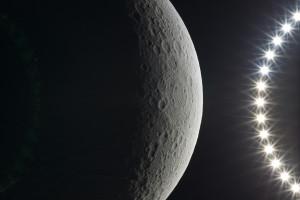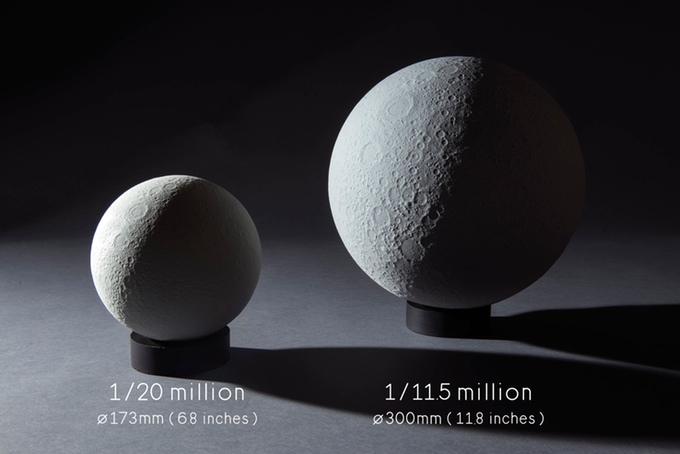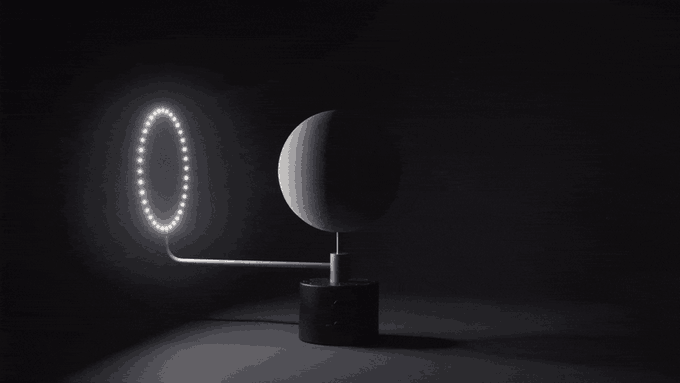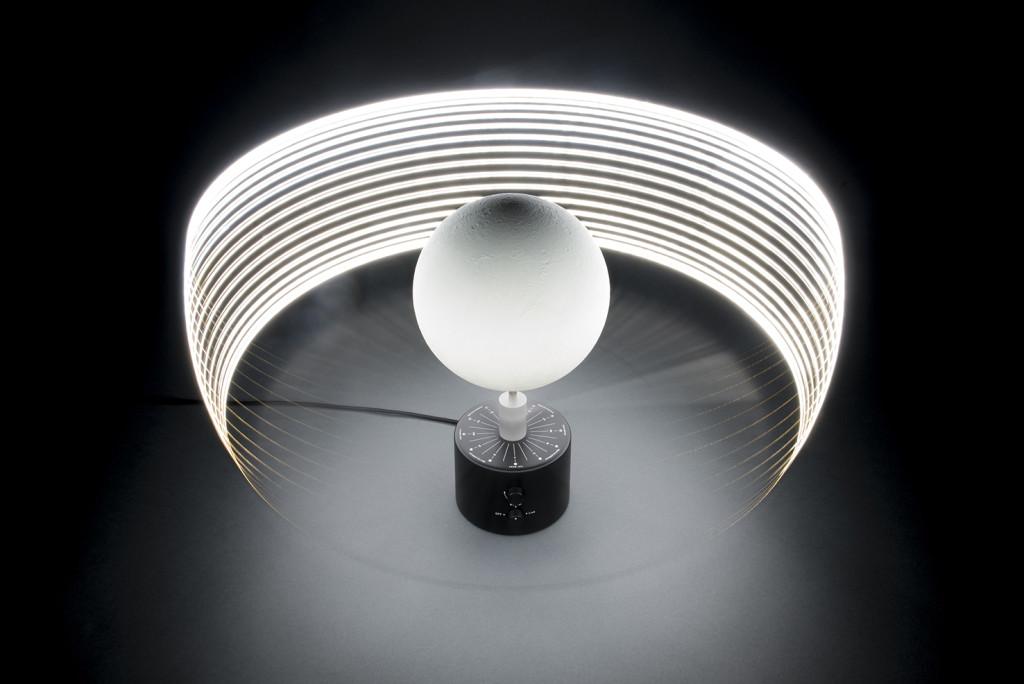 My father, who has taught high school geography courses for decades, used to have a set of globes in his room. One of them was a standard Earth globe, ocean-blue with carefully delineated and brightly colored continents and countries. The other was a moon globe – dust-colored and covered with fantastically named geographical features like the Sea of Tranquility, the Lake of Dreams and the Sea of Nectar. Despite its dull look, I liked the moon globe better, because who wouldn’t want to go visit the Sea of Serenity? (I figured I’d skip the Sea of Crises, though.) That globe was also heavily textured to illustrate mountain ranges, craters, and the “seas” that I was dumbfounded to learn weren’t actually seas at all.
My father, who has taught high school geography courses for decades, used to have a set of globes in his room. One of them was a standard Earth globe, ocean-blue with carefully delineated and brightly colored continents and countries. The other was a moon globe – dust-colored and covered with fantastically named geographical features like the Sea of Tranquility, the Lake of Dreams and the Sea of Nectar. Despite its dull look, I liked the moon globe better, because who wouldn’t want to go visit the Sea of Serenity? (I figured I’d skip the Sea of Crises, though.) That globe was also heavily textured to illustrate mountain ranges, craters, and the “seas” that I was dumbfounded to learn weren’t actually seas at all.
I still remember that globe as being pretty cool, but I could never have imagined how much cooler globes would be once I reached adulthood – lunar globes, in particular. For one thing, technology has allowed us to obtain incredibly detailed and clear images of the moon’s surface, and technology also allows us to reproduce that surface with realistic precision. The new award for “coolest lunar globe I’ve ever seen” goes to French designer Oscar Lhermitte and London design studio Kudu. Their aptly named “MOON” is raising funds on Kickstarter at the moment, and, according to the team, it’s the most accurate lunar globe ever created.
 That may sound like a bold claim, but it could very well be true. MOON’s topographical surface was designed using data from NASA’s Lunar Reconnaissance Orbiter. A fascination with the moon led Lhermitte to contact Germany’s Institute of Planetary Research, which has a team working on the LRO mission, and they were willing to provide him with access to their database. Using data and images from the database, Lhermitte created a 3D model of the entire lunar surface, then 3D printed it as a perfectly accurate, 1/20 million scale model of the moon.
That may sound like a bold claim, but it could very well be true. MOON’s topographical surface was designed using data from NASA’s Lunar Reconnaissance Orbiter. A fascination with the moon led Lhermitte to contact Germany’s Institute of Planetary Research, which has a team working on the LRO mission, and they were willing to provide him with access to their database. Using data and images from the database, Lhermitte created a 3D model of the entire lunar surface, then 3D printed it as a perfectly accurate, 1/20 million scale model of the moon.
“One full Moon was 3D printed in order to become the MOON’s master (the one the molds are then made from),” the team noted on Kickstarter. “After several tests with different 3D printers, materials and techniques, an industrial SLS nylon printer was used with a layer thickness of 100 microns. Oscar took a job with professional mold makers to learn the craft of making the perfect cast.”
The 3D printed moon was used as a mold to cast the resin globes using a rotocasting machine that the team built themselves. The globes, available in two sizes, are incredibly real-looking, with each crater and mountain present in intricate detail and accurate scale. But the really amazing feature of MOON is the “sun” that comes with it. A ring of bright LED lights was connected to a computer, built and programmed by Kudu’s Alex Du Preez and Peter Kreeg, that rotates the ring around the moon, showing the rotation as it appears from Earth. Three different modes of rotation are programmed into the computer. Manual mode allows you to rotate the “sun” yourself to highlight the moon as you wish, while demo mode rotates automatically to show you an entire month-long moon cycle in 30 seconds. Then there’s live mode, which shows you the position of the sun in relation to the moon in real time. Set your controller to live mode, and the MOON in your home will perfectly sync with the phases of the moon in the sky.
It’s obvious that an incredible amount of time and work went into MOON, which has been four years in the making according to the team. That work has paid off, as the two-day-old campaign has already surpassed its £25,000 (about $35,589) funding goal. Want your own MOON? Early bird rewards are already gone, but £300 (about $427) will get you the smaller-sized lunar globe without the sun ring, while £450 ($641) earns you the larger. For £500 ($712) you’ll get both the moon and sun at £200 less than the eventual retail price; £950 ($1,352) gets you the bigger moon plus sun.
If you can’t afford a MOON but still want to support the campaign, there are plenty of smaller rewards that include logo postcards, patches, a moon calendar, and even, for £20 ($28), a sample piece of the MOON so you can see and display the craftsmanship and detail that went into the model.
Smaller rewards will begin shipping as early as July; the globes themselves are estimated to ship around November. If anyone wants to buy me a MOON for Christmas, I won’t protest. Check out the Kickstarter video below. What are your thoughts on this? Discuss in the 3D Printed Lunar Globe forum over at 3DPB.com.
https://ksr-video.imgix.net/projects/2187775/video-656499-h264_high.mp4
Podcast: Play in new window | Download
Subscribe to Our Email Newsletter
Stay up-to-date on all the latest news from the 3D printing industry and receive information and offers from third party vendors.
You May Also Like
Air Force Awards Fortius Metals $1.25M to Qualify 3D Printing Wire for Hypersonic Applications
AFWERX, part of the US Air Force Research Laboratory (AFRL), awarded a Direct-to-Phase II Small Business Innovation Research (SBIR) contract worth $1.25 million to Colorado’s Fortius Metals, to accelerate qualification...
US Air Force Awards JuggerBot $4M for Large-format Hybrid 3D Printing
Large-format 3D printer manufacturer JuggerBot has received a $4 million grant to develop a large format 3D printer, courtesy of the Under Secretary of Defense, Research and Engineering Manufacturing Technology...
Where Have All AM’s Unicorns Gone?
In the rapidly evolving world of 3D printing, startups valued at over a billion dollars, known as unicorns, once seemed as fantastical as the mythical creatures themselves. While a few...
How My Childhood Fascination with Planes Led to Investing in 3D Printing
My fascination with aerospace started young, and I started studying planes–identifying them in the sky and learning everything I could about how they work. Fast forward to my first week...

































